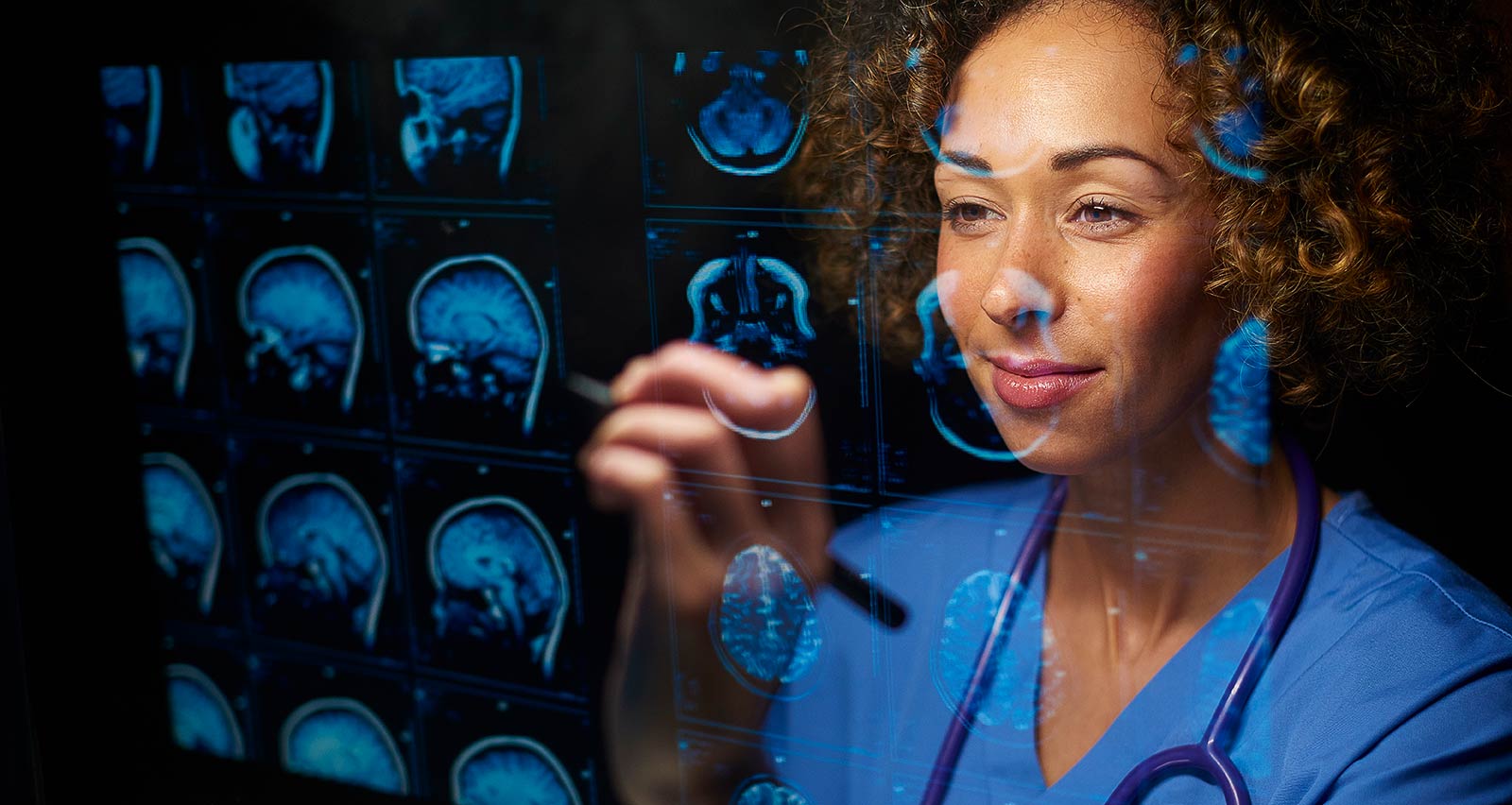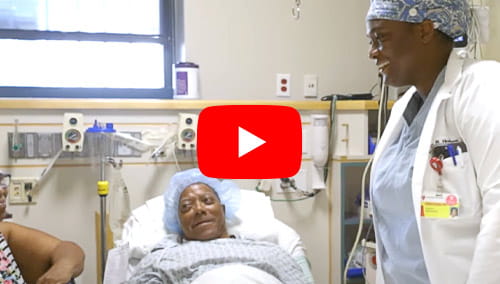
Glioblastoma (GBM)
University Hospitals Seidman Cancer Center’s physicians and oncologists are national leaders in the diagnosis and treatment of glioblastomas and other mixed gliomas, tailoring brain cancer treatment to each patient’s age, health conditions and individual needs. As one of the best cancer hospitals in the country by U.S. News & World Report for over 20 years, UH Seidman Cancer Center is part of the National Cancer Institute (NCI)-designated Case Comprehensive Cancer Center at Case Western Reserve University School of Medicine – one of an elite group of 51 such comprehensive cancer hospitals in the U.S.
Your health is important. Make an appointment today.
Offering in-person, video and telephone visits. Call todayto see which option is right for you. 216-844-3951
Learn more about virtual visits
What Is Glioblastoma?
Glioblastoma, also known as glioblastoma multiforme, is an aggressive and difficult-to-treat cancer that occurs in the brain or spinal cord. It forms from star-shaped cells called astrocytes that support nerve cells. Though glioblastoma can develop at any age, it occurs more often in older adults.
What Are the Symptoms of Glioblastoma?
Pressure on the brain usually causes the first glioblastoma symptoms. Depending on where the tumor develops, signs and symptoms may include:
- Constant headaches
- Seizures
- Vomiting
- Trouble thinking
- Trouble speaking
- Changes in mood or personality
- Double or blurred vision
Innovations in Glioblastoma Treatment
Utilizing some of the most advanced brain cancer treatments available and conducting groundbreaking clinical trials , UH Seidman Cancer Center’s physicians have established many innovations in treating glioblastoma and other brain cancers. This distinction means we have access to advanced treatments and therapies sooner than most other hospitals. With leading-edge clinical trials, UH Seidman Cancer Center’s physicians have established many innovations in special treatment of glioblastoma.
Treatments for glioblastomas include the following:
- Surgery
-
Surgery may be used in both the diagnosis and treatment of glioblastoma. Surgical removal of the tumor helps reduce pressure on nearby parts of the brain. Surgery may be followed by chemotherapy or a combination of chemotherapy and radiation therapy.
Working closely with specialists from University Hospitals Neurological Institute’s Brain Tumor and Neuro-Oncology Center, our fellowship-trained neurosurgeons utilize the latest advances in surgical intervention to treat glioblastoma, including:
- Minimally invasive brain tumor surgery: This approach includes endoscopic techniques through which our neurosurgeons view detailed images of the patient’s brain using a small camera.
- Fluorescence-guided surgery: UH Seidman Cancer Center neurosurgeons have pioneered use of special fluorescent markers (such as 5-ALA) to assist in precisely identifying the borders of the tumor in order to help the surgeon remove more of the tumor while minimizing risk to the brain. Following FDA approval, UH Seidman Cancer Center was the first hospital to use Protoporphyrin IX to make glioblastoma tumors glow hot pink when illuminated with a special blue light during surgery, allowing surgeons to visualize the edges of tumors more clearly and remove them more completely.
- NeuroBlate®: A revolutionary type of laser interstitial thermal therapy that destroys brain tumors with a magnetic resonance imaging (MRI)-guided laser; our hospital is one of only a handful in the world that offers this minimally invasive treatment for previously diagnosed untreatable brain tumors
- Intraoperative MRI: With specialized intraoperative MRI suites, we use magnetic resonance imaging to track surgical progress in real-time
- Radiation Therapy
-
Radiation therapy involves the use of high-energy x-rays or other types of radiation to kill cancer cells or prevent them from growing. Using a machine outside the body, external radiation therapy sends radiation directly toward the area of the tumor. Radiation therapy is often recommended after surgery and may be administered in combination with chemotherapy. For patients who can’t undergo surgery, radiation therapy and chemotherapy may be used as a primary treatment.
Innovative radiation technologies we use in the treatment of glioblastoma include:
- Proton therapy: UH Seidman Cancer Center is the first hospital in Northeast Ohio to offer this innovative, powerful and technologically advanced therapy. Effective for both adults and children, proton therapy has less side effects than other forms of radiation therapy, resulting in better quality of life during treatment, while also reducing patient risk for the development of radiation-induced secondary cancers decades after treatment.
- Stereotactic Radiosurgery
-
Radiation therapy involves the use of high-energy x-rays or other types of radiation to kill cancer cells or prevent them from growing. Using a machine outside the body, external radiation therapy sends radiation directly toward the area of the tumor. Stereotactic radiosurgery differs from traditional radiation therapy in that stereotactic radiosurgery involves the use of precisely focused radiation beams. Unlike traditional radiation therapy, stereotactic radiosurgery exposes very little if any normal tissue to radiation.
Stereotactic radiosurgery is often recommended after conventional surgery and may be administered in combination with chemotherapy. For patients who can’t undergo conventional surgery, stereotactic radiosurgery and chemotherapy may be used as a primary treatment.
Innovative stereotactic radiosurgery technologies we use in the treatment of glioblastoma include:
- Gamma Knife®: An accurate form of stereotactic radiosurgery for the brain, this technology pinpoints a single area with numerous gamma radiation beams without damaging surrounding healthy tissue.
- Varian Edge™: This advanced, high-focus radiation beam radiosurgery system targets the DNA in cancer cells, destroying the cells. Unlike other radiosurgery systems that require the use of a rigid frame to secure a brain cancer patient’s skull during treatment sessions that can last several hours, Varian Edge delivers equally precise treatment without requiring a frame in as little as just a few minutes.
- Chemotherapy
-
Chemotherapy uses drugs to stop the growth of cancer cells, either by killing the cells or preventing their division. When appropriate, your surgeon may use an innovative technique in which thin, circular wafers containing chemotherapy medicine are placed in the brain during surgery. These wafers dissolved slowly to provide the timed release of a medicine that kills cancer cells.
- Tumor Treating Fields (TTF) Therapy
-
TTF utilizes an electrical field to impede the ability of a tumor’s cells to multiply. In TTF, adhesive pads connected to a portable device that generates an electrical field are applied to the patient’s scalp. This therapy is combined with chemotherapy and may be suitable following radiation therapy.
- Targeted Drug Therapy
-
Targeted therapy is an approach to treatment that utilizes drugs or other substances to identify and attack specific cancer cells. In general, targeted therapies inflict less harm to normal cells than chemotherapy or radiation therapy. Promising targeted therapies for glioblastoma include monoclonal antibody therapy, tyrosine kinase inhibitor therapy and vascular endothelial growth factor (VEGF) inhibitor therapy.
Glioblastoma Causes and Risk Factors
As is the case with most brain tumors, experts go not fully understand what causes glioblastoma . However, we know that glioblastoma cells contain more genetic abnormalities than the cells of other types of astrocytomas. Consequently, researchers believe several different genetic mutations are involved in the development of glioblastomas. These mutations may be caused by:
- Inherited DNA defects, especially those associated with genetic conditions such as:
- Turcot syndrome
- Neurofibromatosis type 1
- Li-Fraumeni syndrome
- Cumulative effects of exposure to carcinogens
- High-dose exposure to ionizing radiation
- Other triggers yet to be identified
Glioblastoma tumors can appear in anyone, but are somewhat more common in men and older people. The average age for diagnosis for glioblastoma is 64 years.
Glioblastoma Survival Rates
Doctors can never be absolutely certain about the specific outcome for a patient following a diagnosis of glioblastoma or other types of brain tumor. They can provide an estimate but may be unable to predict other factors, such as how well a patient responds to treatment. As such, glioblastoma prognosis may be revised at different stages of the care journey.
The average survival time for glioblastoma patients at UH is 12 to 14.5 months following diagnosis. Approximately 25% of glioblastoma patients survive more than one year with standard treatment; only 5% of patients survive more than five years. Note that these figures do not predict how long any particular glioblastoma patient will live. For example, depending on their circumstances, a patient who is a 5-year glioblastoma survivor could potentially live as long as someone who has never had the disease.

Pioneering Clinical Research Leads to New Opportunities in Care
University Hospitals is an affiliate of Case Western Reserve University School of Medicine, a nationally recognized leader in clinical research. UH Seidman Cancer Center currently conducts a number of clinical trials for patients with glioblastoma and other mixed gliomas, giving patients access to new and innovative therapies and treatment options.
Reasons to Choose UH Seidman Cancer Center for Glioblastoma Treatment
Following FDA approval, UH Seidman Cancer Center was the first hospital to use Protoporphyrin IX to make glioblastoma tumors glow hot pink when illuminated with a special blue light during surgery. This novel technique allows surgeons to visualize the edges of the tumor more clearly, enabling them to excise it more completely from the brain.
Other reasons to choose UH Seidman Cancer Center for glioblastoma treatment include:
Member of the Adult Brain Tumor Consortium, a consortium of 11 elite Centers of Excellence for brain tumors.
Provides glioblastoma patients with innovative clinical trials
The first stereotactic radiosurgery suite in Ohio to offer Gamma Knife® technology for malignant and benign brain tumors
The first hospital in Ohio to offer proton therapy – an innovative, technologically advanced cancer treatment
The second provider east of the Mississippi to offer Medtronic’s Stealth Autoguide precision robotic platform for brain surgery
The first cancer center to offer GammaTile®, a form of radiation that dissolves in the patient’s brain after placement at the end of brain surgery
One of the leading centers in the country for minimally invasive (Laser Interstitial Thermotherapy) combined with immunotherapy

Patient Stories
Frances’ Story: The Stars Align
After years of catering to the stars, Frances Noonan has an eye for the best. The Colorado woman also knows one’s luck can change in an instant, and traveling for a better experience can be well worth the trip.
Compassionate, Highly Trained Team of Experts
We put the patient at the center of a compassionate, highly accomplished team of brain cancer experts. This multidisciplinary group evaluates and reviews every case so that diagnosis and treatment decisions are based on the team’s combined expertise. Together, we work through every step of cancer care, always with a cure in mind. Our care team comprises:
- Genetic counselors
- Medical geneticists
- Medical oncologists
- Nurse navigators
- Nurse practitioners
- Pathologists
- Radiation oncologists
- Radiologists
- Social workers
- Surgical oncologists
Furthermore, at UH Seidman Cancer Center, each patient’s case is presented at weekly tumor board meetings, where our team conducts a disease-specific tumor board review to ensure that all treatment options are considered.



